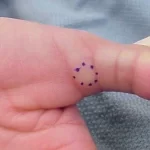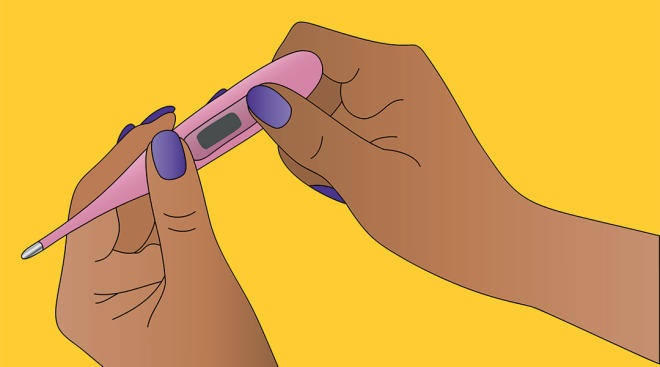Basal temperature is the lowest temperature the body reaches at rest, usually during sleep. It is, therefore, the temperature we have when we wake up, even without getting out of bed. The daily measurement of the basal temperature allows calculating the fertile days in the menstrual cycle. Do you want to know how?
Throughout the menstrual cycle, the basal body temperature experiences variations. Thus, we know that, due to the secretion of progesterone by the ovary, just after ovulation, this temperature increases between 0.3 and 0.5 degrees, remaining elevated until the next menstrual period.
Therefore, keeping a record of your basal temperature throughout the cycle can help you calculate your fertile days simply and inexpensively, increasing your chances of achieving pregnancy.
How to measure basal temperature
Measuring the basal temperature is a simple process, but it requires a lot of perseverance and adherence to specific guidelines.
Every day, from the fourth or fifth day of the cycle until the first day of the next cycle, always before getting out of bed, take your temperature orally, rectally, or vaginally (always the same).
Orally: place the tip of the thermometer under your tongue and keep your lips closed.
Vaginally: insert the thermometer into the vagina.
Rectally: use petroleum jelly or lubricant and insert the thermometer's tip into the rectum while you are in the fetal position.Use a thermometer, mercury, or digital:
It is essential that you always measure your basal temperature simultaneously and after having slept for a minimum of three hours. Variations in the measurement schedule should also be noted since taken one hour later; the basal temperature can rise one-tenth or decrease if taken one hour earlier than usual. It would be best to consider what may be affecting the temperature (a copious dinner, a cold, alcohol consumption, staying up late, taking some medication, a change of thermometer, etc.).
If you use a mercury thermometer, leave it every night with the mercury below 35ºC. In the case of taking the temperature orally, you should put it on for about 5 minutes and, if it is vaginal or rectal, 3 minutes.
If you use a digital thermometer, after about 60 seconds, the thermometer will beep to warn you that the temperature is taken.
If you work a night shift, you should take it after the most extended rest period.
How to record basal temperature
To record your temperatures, design a graph whose vertical axis is the temperature and the horizontal axis is the days of the cycle. Each day when you take your temperature, write it down on the graph to form a line later.
This will allow you to check the unevenness (between 0.2ºC and 0.5ºC) that occurs at a certain point in the cycle, just when the ovary begins to produce progesterone one day after ovulation occurs. You will not be able to identify the exact moment of ovulation directly, but considering that the fertile period begins four days before the ovulation date and ends about 24 hours later, it will be easy for you to establish a more or less regular pattern of most fertile days of your cycle.
It is essential to keep in mind that you will only record the moment of ovulation once it has occurred. Therefore, monitoring the basal temperature curve for at least two consecutive menstrual cycles is recommended before a reliable interpretation of the data can be made.
The behavior of basal temperature throughout the cycle
During the first days of the cycle, the temperature usually oscillates between 36 ° C and 36.6 ° C.
Twenty-five hours after ovulation, the temperature rises sharply by 0.3 and 0.5 ° C.
An egg lives for approximately 12 to 15 hours. Therefore, having sex after the increase in temperature does not allow fertilization.
The temperature drops again immediately after the appearance of the rule, at the end of the cycle.
How to know the fertile days?
If you observe a regular pattern (increase in temperature from the same day) for several months, your fertile days will be those before the temperature rises. By having sexual intercourse in the days before that temperature change, you will be more likely to get pregnant.
This is because, in theory, you will have already ovulated, and the ovum is already ready, even if the change in temperature does not indicate it, which will occur 24 hours later.
Remember that the measurement and recording of the basal temperature are several methods to know the fertile days that you can use. In any case, and although it is a reasonably effective method, the safest thing is to combine it with other ovulation control methods, observing the menstrual cycle on the calendar and the flow.
Jo vaginal, because there are factors that can alter its exact measurement.
Tips for basal temperature measurement
Record your basal temperature every day of the cycle from the fourth or fifth day of menstruation.
When you go to sleep, leave the thermometer within reach, so you don't have to get out of bed to get it. If you have to get up to look for it, the measurement will not be valid.
Take note of your basal temperature for several months to detect possible irregularities in the cycle and establish your calendar.
If you have a fever or are sick, the data for those days is useless, and this fact must be recorded.
Try to always use the same thermometer without changing it during the cycle.
Always take your temperature in the same part of your body.Why is it done
Basal temperature can be used as a way to predict fertility or as part of a contraceptive method, helping you determine the optimal days to have or avoid unprotected sex.
Keeping a basal body temperature to predict fertility or contraception is inexpensive and has no side effects. Some women may decide to use the basal temperature method for religious reasons.
The basal temperature method can also be used to detect pregnancy. After ovulation, an increase in basal temperature that lasts 18 days or more can be an early indicator of pregnancy.
The basal temperature method is often combined with the cervical mucus method for natural family planning, in which you keep track of cervical secretions during the menstrual cycle. You can also use an electronic fertility monitor to measure hormone levels in your urine, indicating which days you are fertile. This combination of approaches is sometimes referred to as the symptothermal or syntohormonal method.
Request a Consultation at Mayo Clinic
Risks
Using the basal temperature method to promote fertility is safe.
Also, using the basal temperature method as a contraceptive does not pose any immediate risk; however, it does not offer protection against sexually transmitted infections and is one of the least effective natural family planning methods. Up to 1 in 4 women, maybe even more, who use fertility awareness-based methods to prevent pregnancy will become pregnant after a year of regular use.
Using the basal temperature method in conjunction with another fertility awareness-based method for contraception can improve the effectiveness. But the method requires motivation and diligence. If you don’t want to conceive a child, you and your partner should avoid having sex or use barrier birth control during your fertile days each month.

















Add Comment